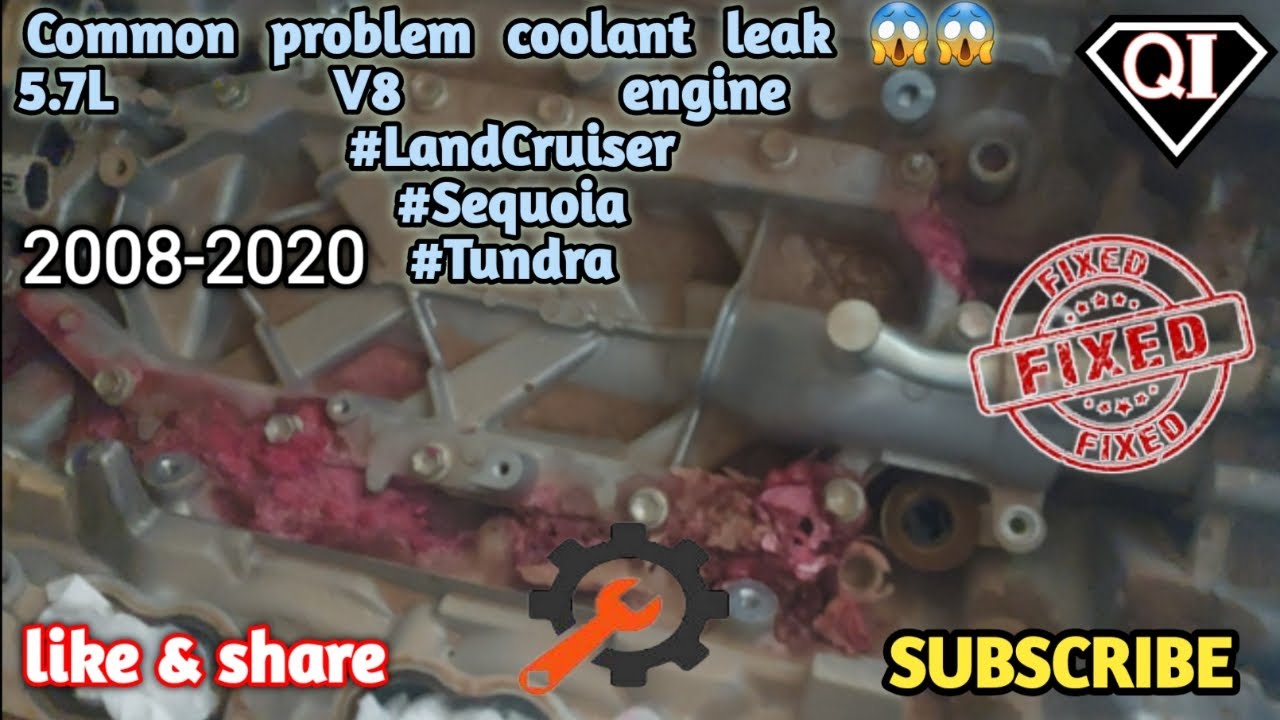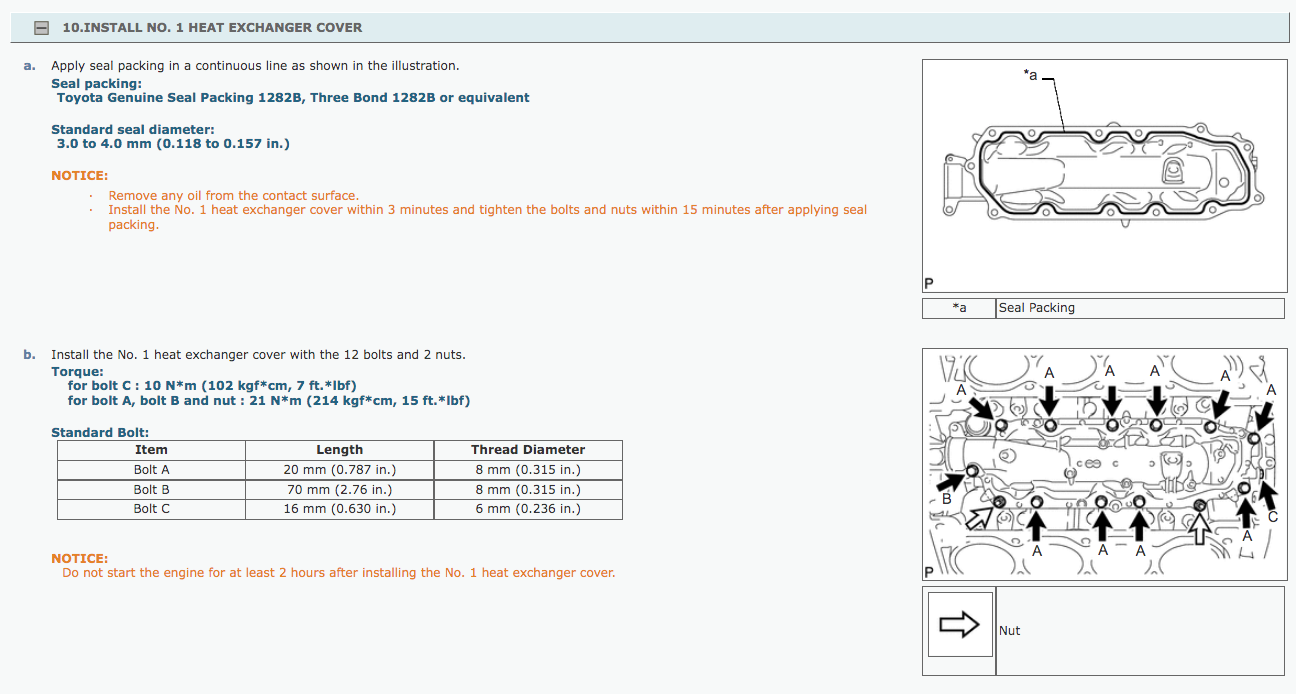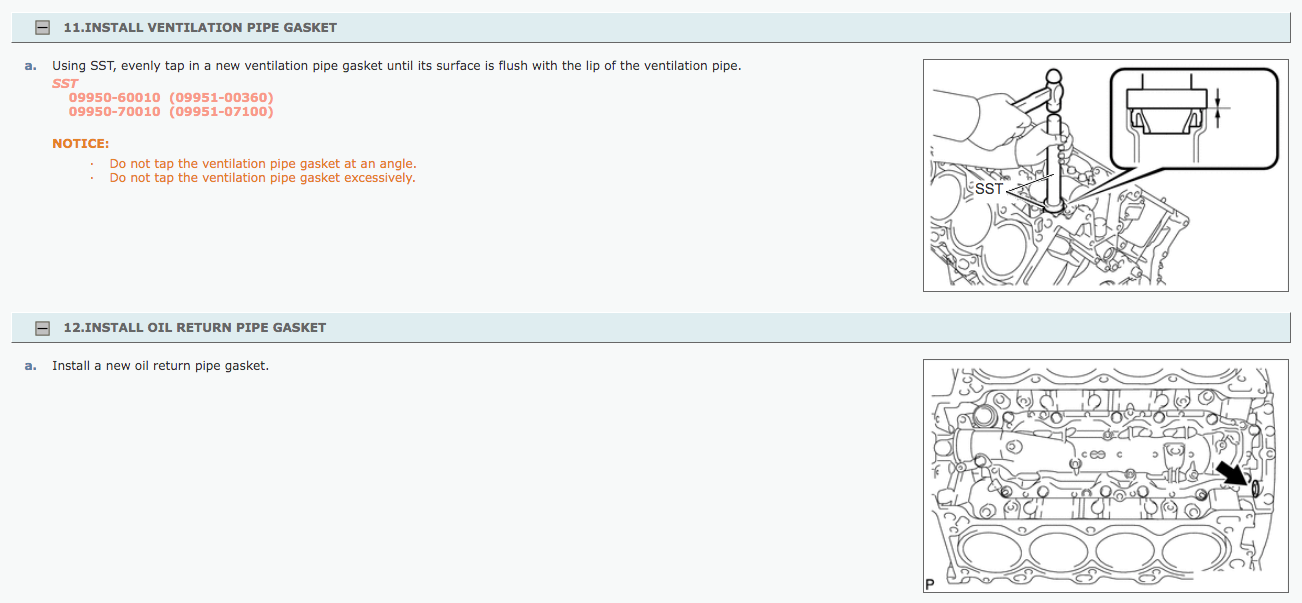The coolant valley plate leak is a potential issue that arises on the GX460 platform (and other 4.6 L V8 1UR-FE engine equipped Toyota's and Lexus's) as the mileage gets to around 100K. A key sign that your GX suffers from this issue is a low coolant condition and coolant running down the backside of your engine and down the transmission bell housing. If you crawl under the GX behind either of the front wheels and look up at the transmission bell housing, you can see evidence of pink/red coolant leaking.
The dealership typically charges about $1,500 for the repair. About $200 for parts and charge 6-8 hours of labor. You can DIY the repair for about $110 as a bare minimum, a bit more depending on other items you might want to replace while the engine bay is opened up. I personally replaced the leaking gasket, manifold gasket, a couple EGR cooler line gaskets, PCV valve, water pump, thermostat and radiator (for about $500, OE gaskets, FIPG, PCV valve, water pump and thermostat from MyLParts.com and Denso radiator and Toyota SuperLongLifeCoolant from Amazon). Other's may want to consider the tensioner pulley, serpentine belt and upper/lower radiator hoses.
It isn't an overly difficult job, but is time consuming (the first time) and there's a few steps that can be considered frustrating, especially if you're not used to DIYing things of this nature. It is, at the end of the day, just removing nuts and bolts, disconnecting coolant and air lines and sensors, cleaning up a gasket mating surface, reapplying the FIPG (Form In Place Gasket) and reassembling everything, some with torque specs in mind and refilling the coolant. None of these individual steps are hard, there's just lots of them, some brittle plastic parts involved and some details that need patience.
I didn't plan to write up this DIY, but I took enough pictures and did the job twice, so I felt I had a good grasp of the job and wanted to share the information the best I can with the GX crowd as I have a feeling more of us will eventually be faced with this repair and may not love the idea of $150/hr labor to fix it.
Bare minimum parts needed for repair:
00295-00103 Qty 1 - Form In Place Gasket (FIPG) Some say to use 08826-00100 aka ThreeBond 1282B, but I couldn't find it easily and my research shows dealerships using the 00103 for this repair.
96761-35035 Qty 2 - Engine Coolant Pipe O-Rings
17171-0S030 Qty 2 - Intake Manifold Gaskets
25685-38010 Qty 1 - EGR Cooler Outlet Gasket
25629-38010 Qty 1 - EGR Cooler Inlet Gasket
00272-SLLC2 Qty 2 - Toyota SuperLongLifeCoolant 50/50 mix (Though three gallons is probably more realistic, I used ever bit of 2 gallons and could use a touch more for top off or any spills).
Optional but advised (due to cheapness):
12204-38010 Qty 1 - PCV Valve (I've had these clog up on other higher mileage vehicles, for $7 and where it lives in the engine, I saw value in replacing it while in there)
Tools needed:
- E8 size female torx socket
- Basic wrenches, 10-12-13-14 MM wrenches and sockets (of both shallow and deep depth) 19MM wrench (or crescent wrench that size) if replacing the PCV valve.
- 3/8" (and 1/4" if you have already) ratchet and various length extensions
- Various pliers (small, slip joint, angled, needle nose)
- Torque wrench capable of 7-35 ft lbs range
- Pry bar (about medium sized is best, though a screwdriver will work fine)
- Flat blade screw driver/plastic rivet removal tool
- Brake cleaner or equivalent for cleaning gasket surface area
- Plastic razor blades or equivalent for cleaning gasket surface area
- Rags and tape (for scrubbing areas and taping off intake inlets and other tubes)
- Magnetic grabber (magnet on a stick, very...very helpful for those hard to reach spots)
- Funnel (for refilling coolant)
- Portable work light (not a must, but helpful in the dark corners)
- Shop-vac capable of liquid (or be prepared to use a lot of rags to soak up coolant in the pan/valley areas, maybe even a siphon or turkey baster in a pinch)
- Access to compressed air is helpful, for blowing out debris and coolant from misc areas in the valley
As a general disclaimer: I'm not writing this DIY in complete minuet detail. My intentions are to display what the job entails and help shine a light on some of the basic steps taken when I performed this repair. I'll likely miss a few little steps, forget to point out a bolt or clip to remove, etc but I'm assuming the average person taking on this repair can overcome a simple missing detail. This is an attempt to show most general steps, though I'll be as thorough as memory and pictures allow me to be. Don't rely on my guide solely, use the factory repair manual, other threads and common sense to make sure you can perform each task correctly. Feel free to ask questions to any steps that aren't clear and I'll try to elaborate more where needed.
To start, you'll need to let the vehicle cool down, disconnect the battery and remove the main plastic engine cover. Then remove the air intake tube and associated lines between the air box and throttle body. It will make disassembly and reassembly of this section of intake tube easier if you remove the air box top cover.

On top of the intake manifold, remove the bolt holding multiple air hoses on (place bolt back in empty hole for storage) and disconnect the single hose closest to the firewall and tuck it away to the passenger side of the engine. The remaining two hoses and T connection will rotate to the driver side to be tucked away.

Starting at the top of this picture, remove two 10MM bolts and the engine beauty cover bracket.
Center of the intake manifold, passenger side, unclip the EGR valve assembly and remove three (3) 12MM bolts holding the main assembly on, then follow the metal lines towards the front of the engine and remove four (4) 10MM nuts where the EGR lines run into the intake and under the intake manifold.
Center of the intake manifold, drivers side, unclip the Purge Valve and VSV connections and unhook the small purge line, also remove the small purge line from it's support clip to the right of the main connection so it can be moved out of the way.
Bottom right corner of the intake manifold, unclip the Manifold Pressure sensor and follow the wiring down to where it's secured on a bracket closer to the radiator and remove that clip as well.
Disconnect the Throttle Body electrical connection and remove the two (2) 10MM bolts holding the Secondary Air Pump hose bracket to the throttle body. I broke this tube in two places by the end of the job, mine was very brittle. Follow the air hose to the driver side valve cover and disconnect the hose clamp at that junction.

With that out of the way, we can see two additional tubes we need to disconnect. The PCV valve connection on the bottom right corner of the intake manifold and a coolant line under the bottom center neck of the manifold. **IF YOU DON'T WANT COOLANT ON YOUR SERPENTINE BELT, DO SOMETHING TO AVOID IT WHEN DISCONNECTING THIS LINE**

Now to an area that I struggled with for a long while, disconnecting the main engine wiring harness and crossover fuel line from the backside of the intake manifold.
Here are the three (3) connections on the back of the manifold you need to undo somehow. One (1) 10MM bolt through the fuel line supporting bracket and two (2) L bracket connections to mounts on the main wiring harness loom. Backside of the intake manifold, that would be butted up against the fire wall.

The dealership typically charges about $1,500 for the repair. About $200 for parts and charge 6-8 hours of labor. You can DIY the repair for about $110 as a bare minimum, a bit more depending on other items you might want to replace while the engine bay is opened up. I personally replaced the leaking gasket, manifold gasket, a couple EGR cooler line gaskets, PCV valve, water pump, thermostat and radiator (for about $500, OE gaskets, FIPG, PCV valve, water pump and thermostat from MyLParts.com and Denso radiator and Toyota SuperLongLifeCoolant from Amazon). Other's may want to consider the tensioner pulley, serpentine belt and upper/lower radiator hoses.
It isn't an overly difficult job, but is time consuming (the first time) and there's a few steps that can be considered frustrating, especially if you're not used to DIYing things of this nature. It is, at the end of the day, just removing nuts and bolts, disconnecting coolant and air lines and sensors, cleaning up a gasket mating surface, reapplying the FIPG (Form In Place Gasket) and reassembling everything, some with torque specs in mind and refilling the coolant. None of these individual steps are hard, there's just lots of them, some brittle plastic parts involved and some details that need patience.
I didn't plan to write up this DIY, but I took enough pictures and did the job twice, so I felt I had a good grasp of the job and wanted to share the information the best I can with the GX crowd as I have a feeling more of us will eventually be faced with this repair and may not love the idea of $150/hr labor to fix it.
Bare minimum parts needed for repair:
00295-00103 Qty 1 - Form In Place Gasket (FIPG) Some say to use 08826-00100 aka ThreeBond 1282B, but I couldn't find it easily and my research shows dealerships using the 00103 for this repair.
96761-35035 Qty 2 - Engine Coolant Pipe O-Rings
17171-0S030 Qty 2 - Intake Manifold Gaskets
25685-38010 Qty 1 - EGR Cooler Outlet Gasket
25629-38010 Qty 1 - EGR Cooler Inlet Gasket
00272-SLLC2 Qty 2 - Toyota SuperLongLifeCoolant 50/50 mix (Though three gallons is probably more realistic, I used ever bit of 2 gallons and could use a touch more for top off or any spills).
Optional but advised (due to cheapness):
12204-38010 Qty 1 - PCV Valve (I've had these clog up on other higher mileage vehicles, for $7 and where it lives in the engine, I saw value in replacing it while in there)
Tools needed:
- E8 size female torx socket
- Basic wrenches, 10-12-13-14 MM wrenches and sockets (of both shallow and deep depth) 19MM wrench (or crescent wrench that size) if replacing the PCV valve.
- 3/8" (and 1/4" if you have already) ratchet and various length extensions
- Various pliers (small, slip joint, angled, needle nose)
- Torque wrench capable of 7-35 ft lbs range
- Pry bar (about medium sized is best, though a screwdriver will work fine)
- Flat blade screw driver/plastic rivet removal tool
- Brake cleaner or equivalent for cleaning gasket surface area
- Plastic razor blades or equivalent for cleaning gasket surface area
- Rags and tape (for scrubbing areas and taping off intake inlets and other tubes)
- Magnetic grabber (magnet on a stick, very...very helpful for those hard to reach spots)
- Funnel (for refilling coolant)
- Portable work light (not a must, but helpful in the dark corners)
- Shop-vac capable of liquid (or be prepared to use a lot of rags to soak up coolant in the pan/valley areas, maybe even a siphon or turkey baster in a pinch)
- Access to compressed air is helpful, for blowing out debris and coolant from misc areas in the valley
As a general disclaimer: I'm not writing this DIY in complete minuet detail. My intentions are to display what the job entails and help shine a light on some of the basic steps taken when I performed this repair. I'll likely miss a few little steps, forget to point out a bolt or clip to remove, etc but I'm assuming the average person taking on this repair can overcome a simple missing detail. This is an attempt to show most general steps, though I'll be as thorough as memory and pictures allow me to be. Don't rely on my guide solely, use the factory repair manual, other threads and common sense to make sure you can perform each task correctly. Feel free to ask questions to any steps that aren't clear and I'll try to elaborate more where needed.
To start, you'll need to let the vehicle cool down, disconnect the battery and remove the main plastic engine cover. Then remove the air intake tube and associated lines between the air box and throttle body. It will make disassembly and reassembly of this section of intake tube easier if you remove the air box top cover.
On top of the intake manifold, remove the bolt holding multiple air hoses on (place bolt back in empty hole for storage) and disconnect the single hose closest to the firewall and tuck it away to the passenger side of the engine. The remaining two hoses and T connection will rotate to the driver side to be tucked away.
Starting at the top of this picture, remove two 10MM bolts and the engine beauty cover bracket.
Center of the intake manifold, passenger side, unclip the EGR valve assembly and remove three (3) 12MM bolts holding the main assembly on, then follow the metal lines towards the front of the engine and remove four (4) 10MM nuts where the EGR lines run into the intake and under the intake manifold.
Center of the intake manifold, drivers side, unclip the Purge Valve and VSV connections and unhook the small purge line, also remove the small purge line from it's support clip to the right of the main connection so it can be moved out of the way.
Bottom right corner of the intake manifold, unclip the Manifold Pressure sensor and follow the wiring down to where it's secured on a bracket closer to the radiator and remove that clip as well.
Disconnect the Throttle Body electrical connection and remove the two (2) 10MM bolts holding the Secondary Air Pump hose bracket to the throttle body. I broke this tube in two places by the end of the job, mine was very brittle. Follow the air hose to the driver side valve cover and disconnect the hose clamp at that junction.
With that out of the way, we can see two additional tubes we need to disconnect. The PCV valve connection on the bottom right corner of the intake manifold and a coolant line under the bottom center neck of the manifold. **IF YOU DON'T WANT COOLANT ON YOUR SERPENTINE BELT, DO SOMETHING TO AVOID IT WHEN DISCONNECTING THIS LINE**
Now to an area that I struggled with for a long while, disconnecting the main engine wiring harness and crossover fuel line from the backside of the intake manifold.
Here are the three (3) connections on the back of the manifold you need to undo somehow. One (1) 10MM bolt through the fuel line supporting bracket and two (2) L bracket connections to mounts on the main wiring harness loom. Backside of the intake manifold, that would be butted up against the fire wall.
Last edited:








